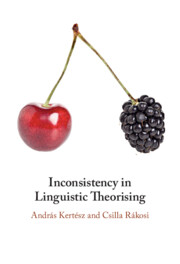Book contents
- Inconsistency in Linguistic Theorising
- Inconsistency in Linguistic Theorising
- Copyright page
- Dedication
- Contents
- Figures
- Tables
- Preface
- Abbreviations and central terms
- 1 Introduction
- Part I The State of the Art
- Part II Paraconsistency
- Part III Plausible Argumentation
- Part IV Summary
- 10 The Methodological Background
- 11 Conclusions
- References
- Index
10 - The Methodological Background
from Part IV - Summary
Published online by Cambridge University Press: 23 June 2022
- Inconsistency in Linguistic Theorising
- Inconsistency in Linguistic Theorising
- Copyright page
- Dedication
- Contents
- Figures
- Tables
- Preface
- Abbreviations and central terms
- 1 Introduction
- Part I The State of the Art
- Part II Paraconsistency
- Part III Plausible Argumentation
- Part IV Summary
- 10 The Methodological Background
- 11 Conclusions
- References
- Index
Summary
After we have seen how the p-model works, this chapter evaluates the p-model’s methodology with respect to current tendencies in the history and philosophy of science.sketches four interrelated processes. First, the fall of the analytical philosophy of science was accompanied by the historical turn that yielded the emergence of the discipline ‘the history and philosophy of science’. Second, as opposed to the earlier programme of unified science, by now the philosophy of science has acknowledged the pluralism of scientific inquiry. Third, there is also a process that has led to the simultaneous presence of the general philosophy of science and the discipline-specific histories and philosophies of science. Finally, there is a pluralism of the specific histories and philosophies of science within the discipline as well. The p-model fits into these processes.reflects on the basic method applied by the history and philosophy of science, namely, case studies. It outlines the p-model’s answer to the question of why the results of single case studies may be generalised and how they can be selected without bias.is devoted to the question of whether our results can be applied to other fields of linguistic research than those mainstream grammatical approaches that the case studies have focused on.
Keywords
- Type
- Chapter
- Information
- Inconsistency in Linguistic Theorising , pp. 293 - 299Publisher: Cambridge University PressPrint publication year: 2022

